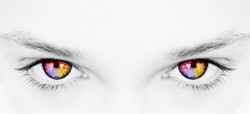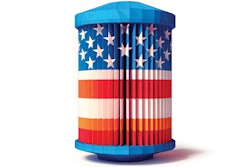
Only recently, however, have relatively inexpensive colorimeters or photometers come on the market that take the squint out of determining colors in water tests. The devices coming into the market today, as opposed to their predecessors, are also lighter and easier to operate.
They don't change the actual test result, and a keen, experienced eye can still produce an accurate reading of a reagent mixture or test strip under ideal conditions. But in actual practice, poor visibility of the test sample or test strip or a genetic inability to see colors accurately can lead to an inaccurate reading.
By introducing the objectivity of the machine, it's possible to replace our natural subjectivity with a more uniform, precise color reader.
The Problem
"The problem is that some people just don't see colors well," says Joe Sweazy, technical sales and service manager, Hach Company, Elkhart, Ind.
He refers to the Munsell 100 Hue test, a vision test that is administered using panels of colors with slight variation, in which the subject lines up panels in order to display a smooth change in hue. It tests the same color-order skill needed to match water samples or test strips to comparator charts.
According to this test, in a typical population, Sweazy says, 16 percent have superior color discrimination, 68 percent have average color discrimination, and 16 percent have below-average color discrimination. And within that below-average group, 8 percent of males and 2 percent of females are colorblind.
"If you're completely colorblind you see only shades of gray," he says, "but there are other forms of colorblindness - the most common form in men is red/green colorblindness - in which those cones in your eyes don't function properly, and you see different colors than everyone else sees. You see color, but not the same way that other people do."
For this significant percentage of the population, almost one in six, correctly discerning the color of a test sample or strip is either difficult or impossible.
And even the majority of the population with average or above-average color discrimination doesn't have the fine sensitivity of a colorimeter, according to Rich DeMoss, pool/spa market manager, LaMotte Company, Chestertown, Md.
"Let's say for example you are using a test strip," he says, "and you were to dip that into water trying to measure pH. Most pH test strips read like 6.8, 7.2, 7.6, 8.0. Anything between those numbers and you're kind of guessing at the color.
"A colorimeter really takes a lot of the guesswork out of it. Especially when it comes to pH or chlorine, where it's hard to tell the fine differences."
A Light Bounce
The devices are fairly simple. A colorimeter has three main parts - the light source, a chamber where the sample or test strip is housed, and a detector.
For economical reasons, the light is usually an LED, notes Tom Seechuk, industrial market manager, LaMotte Company. "LEDs have an advantage over incandescent light sources in that they last longer and use very little electric power - an advantage for battery-operated meters."
In test kit colorimeters, a beam of light from that LED is passed through the reacted sample. The amount of light absorbed by the sample is directly related to its color. The detector simply reads how much light comes through the reacted sample and does some basic math to come up with a concentration.
Like many detection instruments, the colorimeter needs to be zeroed out in order to adjust for extraneous elements in the sample. For a test kit solution, a sample straight from the pool or spa without any reagents is placed in the chamber and measured to give the meter a starting point or baseline. Then, after the reagents have been added, and the reaction has taken place in the vial, it is again placed in the chamber and measured to find the absolute result.
Different colors (wavelengths) of light are needed to measure different substances, Seechuk says. "The color of the light that is used to measure a particular substance is based on what color is produced when that substance reacts with the reagent system specific to it. The color of the light used for the measurement is the complement of the reaction color. Thus a red light (600-700 nm) is used to measure blue; green light (500-580 nm) is used for pink; blue light (420-480 nm) is used for yellow. Bandpass is a term used to define the 'purity' of the color.
"An LED has a particular central wavelength, but the light it emits could be comprised of up to 30 nm of other wavelengths. This is the bandpass. Filters are used to refine the bandpass by eliminating these extra wavelengths. Typically colorimeters with interference filters have a 5-15 nm bandpass. A smaller bandpass gives more consistent results."
It's slightly different with test strips in AquaChek's TruTest reader, Sweazy says, due to the fact that the strip is solid and opaque and not liquid and translucent. Instead of measuring light that passes through, the colorimeter measures light that bounces off.
"There's a light underneath each one of the test pads - and that light is reflected off the test pad. A read-head measures the reflectance value, and that value is translated into the concentration of the particular parameter," he says.
Improving Sensitivity
Colorimeters have been around for many years, especially for use in water testing stations in retail stores, but due to a drop in price and an increase in functionality, more service professionals are using portable handheld meters in the field.
"At one time," says DeMoss, "it was hard to find an on-site meter for less than, say, $300. Now it seems like there are a lot of manufacturers that offer on-site meters for less than $200. And they're a lot more durable than they once were. So I think the competition has grown, which is good, because that spurs technology."
Sweazy agrees, "The cost per test, as well as the initial investment in the instrument, is dropping down into the range where even consumers are starting to use electronics. The typical retail cost for the TruTest is between $50 and $60."
An emphasis on simplicity has given colorimeters a boost, as well, as manufacturers have worked to make the process of using the meters more straightforward.
"If you look at the way these products have developed," says DeMoss, "they require fewer steps now, and that makes them easier to use.
"Quicker, easier, improved sensitivity, and less cleanup when you're done, that's the direction of it."
Go Ahead, Be Clinical
There are some precautions to take in using colorimeters
If you are using tubes and glassware, it's important to put the tubes into the chamber the same way each time you use it, notes Tom Seechuk, industrial market manager, LaMotte Company. "If a round sample tube is rotated 90 degrees in the chamber, the reading may change as much as 0.2 ppm."
In addition, the sample tubes should be cleaned immediately after testing. Some reactions, if left to stand, can discolor the sample tubes to the extent that the meter will show a reading on unreacted water.
For that reason, he says, colorimeters should be kept dry. The user should thoroughly wipe dry all sample tubes placed in the chamber. If water and/or reagents get onto the light source or detector, it will interfere with proper absorbance readings.
Another point to be aware of, adds Joe Sweazy, technical sales and service manager, Hach Company, Elkhart, Ind., is the specific range of the colorimeter you are using. If the range of the colorimeter is narrower than the range of the water test, readings at the extreme end of that range will be inaccurate.
For instance, if the top end of the range of a colorimeter corresponds to a pH of 8.6, and the actual pH of the water you are testing is 9.0, this may produce an error reading in the colorimeter.
-S.W.
Pentair Salt Chlorine Reader
Pentair Water Pool and Spa, Sanford, N.C., has just come onto the market with the QuickTest, a handheld meter to measure the level of salt in pools that use salt chlorine generators.
Generators come equipped with an onboard meter to measure the salt level, but according to Zack Pickard, product manager, these onboard meters may be limited in range and precision.
"On pool startup or conversion to salt chlorine generation," he says, "often the user may not know where they stand in terms of sodium chloride. The QuickTest can double check a salt chlorine generator and determine, 'Is this unit doing what I think it's doing?'
"The QuickTest gives you an exact sodium chloride level from 0 - 9,999 ppm with a +/- 2 percent accuracy, so it's a useful tool to help a pool pro or homeowner determine the precise salt level if the actual level is above or below the sensing range of the onboard meter on the salt chlorine generator unit itself."
-S.W.








































